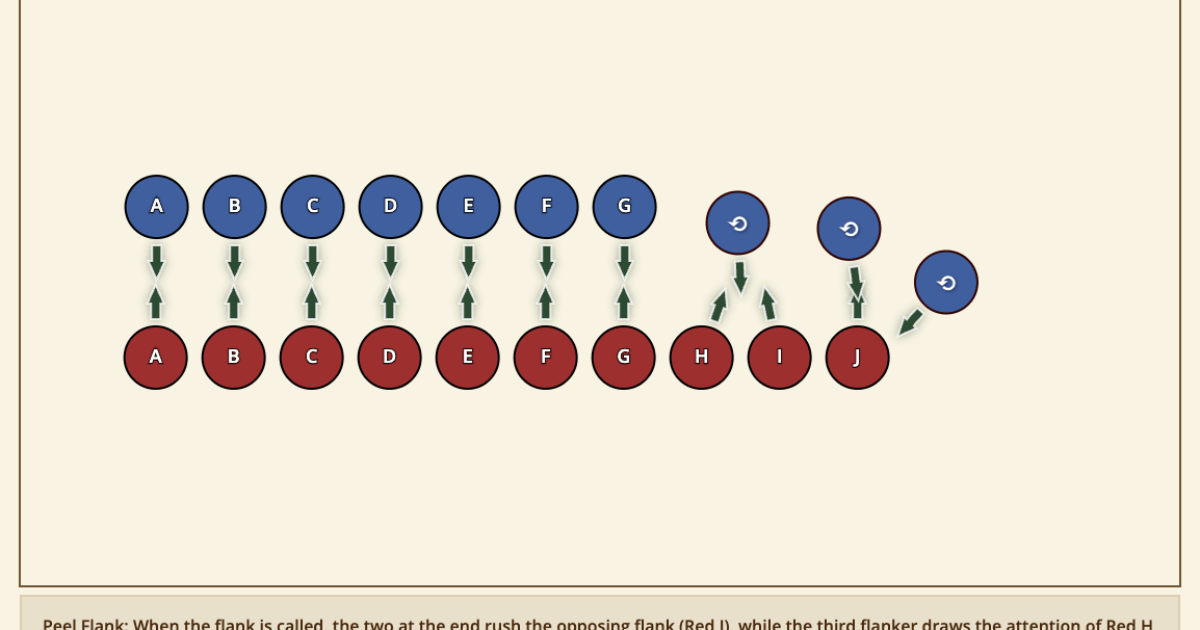Somewhere between lacing up your shoes and starting your first set of duels, you face the most important decision of your workout: Warm up, or not? There’s a good chance you just skip it. After all, you can barely carve out time for practice. Who wants to waste one valuable sword-clashing minute on tedious knee hugs and neck rolls?
But the short-term investment pays off big-time if you do it right. “The best way to warm up is with dynamic stretching,” says Nick Tumminello, owner of Performance University in Baltimore. This stretches a muscle at its full range of motion (a body-weight lunge is a great example).
Dynamic stretching increases flexibility, improves blood flow, and decreases your risk of injury and your recovery time. Translation: Your fights (or workouts) will feel easier, and you’ll see faster results. This three-part dynamic warm-up gets your heart rate up, your muscles prepped, and your body seriously ready to turn heads.
1. Turn It On: Nervous System Activation (Moves 1-3)
Even if your brain is saying “Bring it!”, your muscles aren’t ready to work when you first come to practice. Your central nervous system, which controls movement and activity, is basically in “power save” mode (blame it on a day at the desk or hours in front of the TV). So before you jump into a fight, your brain needs to signal your body that it’s time for quick, explosive activity. These moves kick your nervous system into high gear by calling your coordination into action while raising your heart rate and body temperature. The result: Your muscles respond more effectively during your workout.
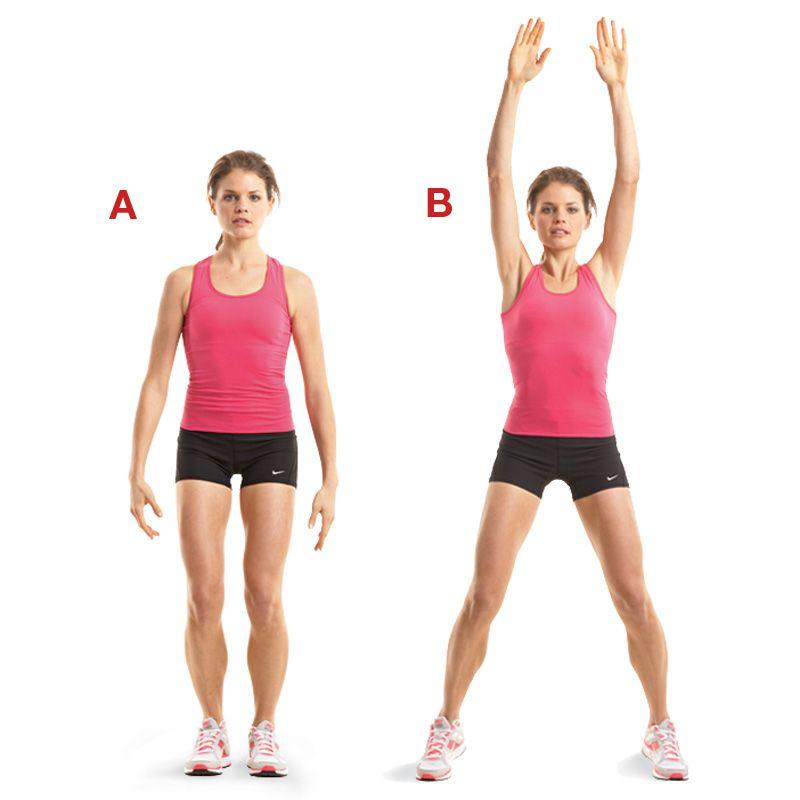
1. Jumping Jacks
Stand with your feet together and your hands at your sides (a). As you raise your arms above your head, jump up just enough to spread your feet wide (b). Without pausing, quickly reverse the movement. Continue for a total of 10 to 15 reps.

2. Crossover Jumping Jacks
Stand with your feet more than hip-width apart and your arms straight out to your sides at shoulder level (a). Simultaneously cross your arms in front of your chest and jump up just enough to cross your right leg in front of your left (b). Without pausing, quickly reverse the motion and return to the starting position. Repeat, crossing your left leg in front of your right. Continue alternating feet for a total of 10 to 15 reps.
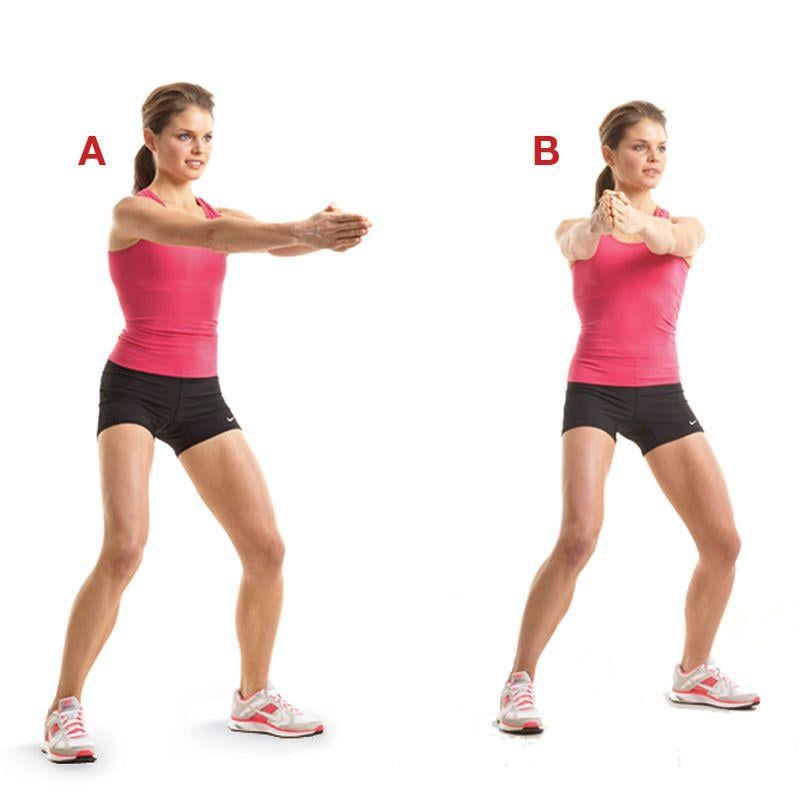
3. Tight Core Rotations
Stand with your feet more than hip-width apart and your arms extended in front of you, palms together (a). Keeping your hips square and your core engaged, rotate your upper body to the right so your arms are in line with your right shoulder (b). That’s one rep. Quickly reverse, twisting all the way to the left so your arms are in line with your left shoulder. Continue alternating as fast as you can for 30 to 40 reps.
2. Up the Ante: Muscle Engagement (Moves 4-6)
Now that you’ve got your heart pumping, this phase will turn on weak and underutilized muscles: glutes, abdominals, hip flexors, and lower and upper back muscles. These “core muscles” are responsible for maintaining stability and control in your joints while you move. Forgetting to activate these muscles raises your risk of injury.
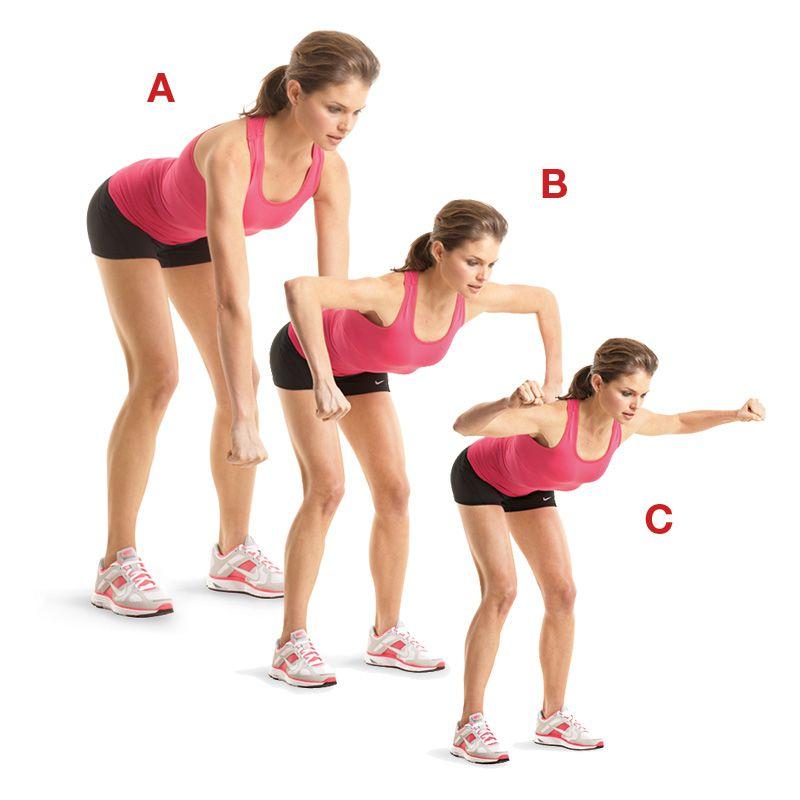
4. Bent-over Row with L-Raise
Bending at your hips, lower your torso until it’s almost parallel to the floor, arms hanging from your shoulders (a). Raise your arms out to shoulder height, bending your elbows 90 degrees (b). Without moving your elbows, rotate your forearms up as far as you can (c). Reverse the motion to return to start. That’s one rep. Do 12 to 14.

5. Super Dog
Kneel and place your elbows on the floor, bent 90 degrees. Slide your left hand forward and stretch your right leg behind you until both are straight (a). Raise your left arm and right leg as high as you can, forming a straight line from your fingertips to your toes (b). Hold for two seconds, then return to start. That’s one rep. Do 12 to 14 on each side.
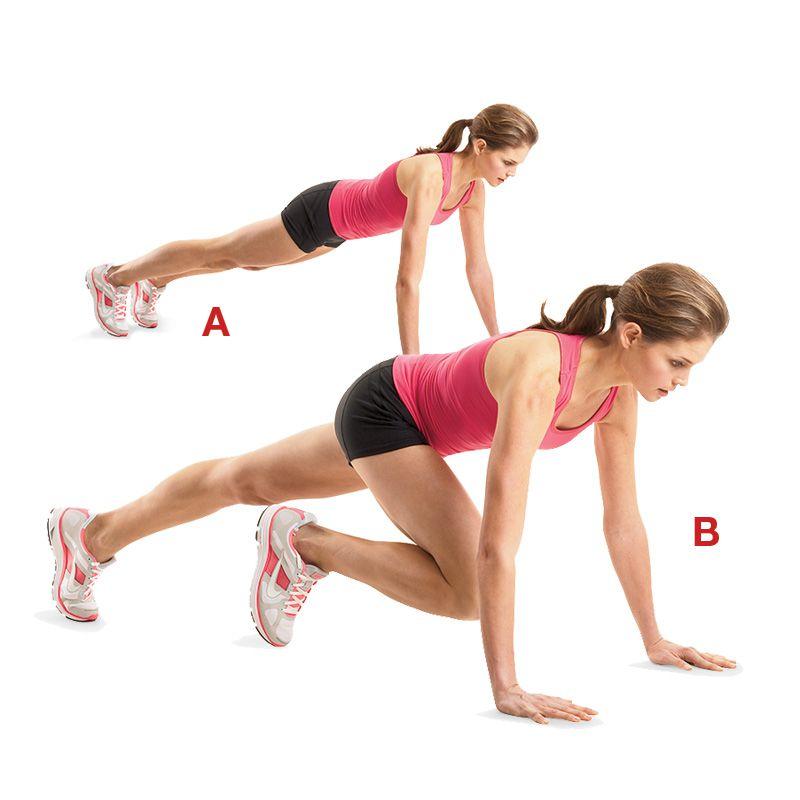
6. Slow-motion Mountain Climber
Start at the top of a pushup (a). Keeping your abs braced, pick up your right foot and slowly bring your knee toward your right shoulder (b). Hold for two seconds, then return to start. Alternate legs until you’ve done 12 to 14 reps (six or seven per leg).
3. Push Further: Dynamic Mobility (Moves 7-9)
For the finale, you’ll increase the range of motion at your joints, while improving the flexibility in your large muscle groups from head to toe. And that’s a big deal: When your mobility is compromised by stiff muscles, you spend more energy fighting against your body’s limitations, rather than fighting your opponent.

7. Arm Crossover
Lie on your left side, with your right knee bent 90 degrees. Straighten both arms in front of you, palms facing each other (a). Keeping your left arm and both legs in position, rotate your torso to the right, until your right hand and upper back are flat on the floor (b). Hold for two seconds, then return to start. Do eight to 10 reps, then repeat on the other side.
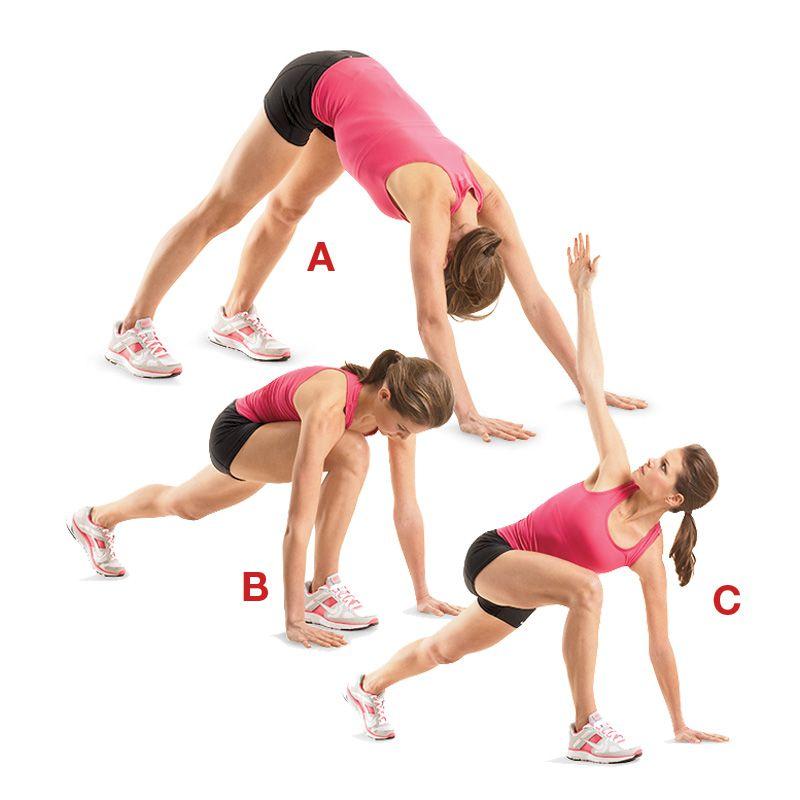
8. Yoga Plex
Start in downward dog, palms and heels flat on the floor, back straight (a). Slowly bring your right foot between your hands (b). Rotate your torso to the right as you reach your right arm toward the ceiling (c). Reverse back to start. Repeat on the other side. Continue alternating until you’ve done five or six on each side.
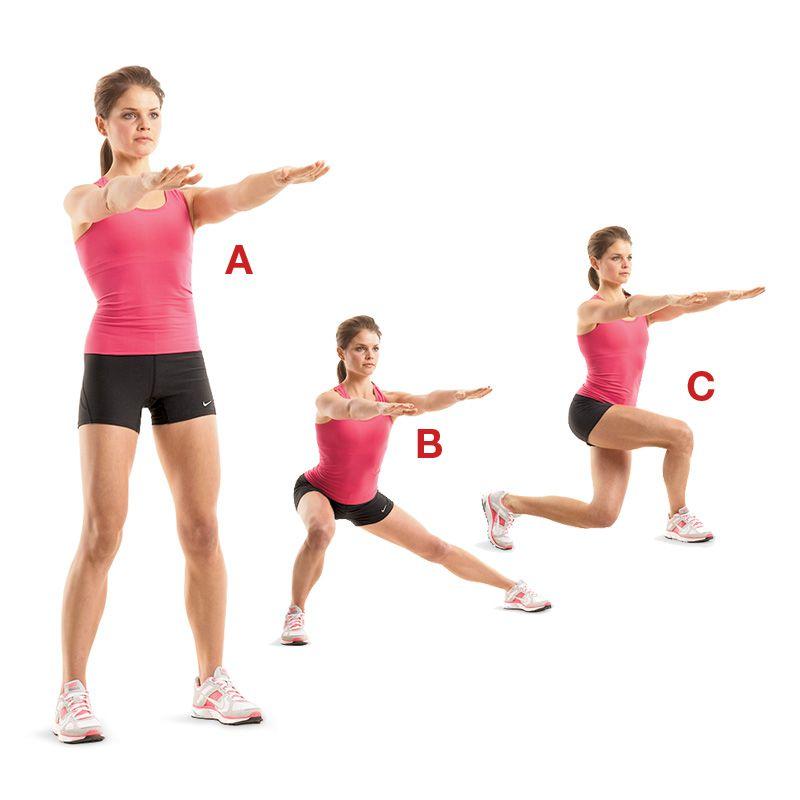
9. Side Lunge to Crossover Lunge Combo
Stand with your arms straight in front of you (a). Step right and lower into a side lunge (b). Bring your left leg behind your right, lowering your knee toward the floor (c). Push off your left foot to stand. Do six to eight reps, then repeat on the other side.
Dynamic Stretches
Always warm up first. “To improve range of motion and avoid injury, you do need to stretch, but don’t ever do it when muscles are cold,” warns orthopedic surgeon William Levine, MD, director of sports medicine at Columbia University Medical Center in New York City. “Always start with some mild aerobic warm-ups to get blood to the tissue before doing any stretching.”
Holcomb recommends brisk walking or slow jogging for about five minutes, rather than stretching before exercise. “Warming up increases blood flow, which increases the temperature in the muscle, which makes the collagen fibers more elastic like a rubber band,” he explains.
After warming up, do dynamic (not static) stretches. Dynamic stretching means slow, controlled movements rather than remaining still and holding a stretch. They may include simple movements like arm circles and hip rotations, flowing movements as in yoga, or walking or jogging exercises like those mentioned below. While studies have not clearly proven this, increasing numbers of experts agree that dynamic stretching is the best stretching routine before a workout or competition. Levine warns, however, that proper technique is key. “Poor technique that is not anatomically correct puts you at higher risk for injury.”
Holcomb recommends three all-purpose dynamic stretches for your lower body:
- Goose-step march: Slowly lift your leg straight out in front of you, alternating as you walk with your normal stride length. While others may think you’re doing a Monty Python skit, it is an effective hamstring stretch.
- Knee lifts: As you’re jogging or walking, bring knees up toward your chest. For a variation, as your right knee comes up, twist the lifted leg gently to the left and your upper body gently to the right for a spinal twist. Repeat on each side as you jog or walk.
- Butt-kick: As you jog or walk, bend one knee and lift it behind you as if you were trying to kick yourself in the butt. It’s not punishment; it stretches the quadriceps.
Do several repetitions of 30 seconds each at your own pace. The point is to do the movements in a controlled way. Stop if you get tired so you still have energy for your workout
Consider yoga. “Isn’t it interesting that this new research is figuring out what yoga teachers have known for thousands of years?” says Mary Pullig Schatz, MD, a retired surgical pathologist, yoga expert, and author of Back Care Basics. If you’re familiar with yoga basics, she suggests, you can use those moves as dynamic stretches before, say, a run or a long bike ride. Try two minutes of sun salutations to stretch multiple parts of the body. Or make downward-facing dog dynamic by pedaling your feel or lifting alternate legs.
“Improving your flexibility allows you to put your body in good ergonomic alignment,” Schatz says. “Yoga can help you combine flexibility and strength, breathe properly, reduce head, neck, and back pain, and put the body back in balance.”
After your workout or competition, then do static stretches. “Too many people do static stretching before and then nothing after,” says Holcomb. “That’s the most common mistake I see.” This is where you’ll lengthen muscles and improve your flexibility. Hold static stretches for about 30 seconds.
Never stretch to the point of pain. Forget the phrase “no pain, no gain. “You do not want pain when you’re doing dynamic stretching,” says Holcomb. “It should be gentle to start and then progress.” When you’re doing your static stretching afterward, you should go to the point of slight discomfort and intensity, he says, to improve your flexibility. But if you’re making a face, your muscle is contracting to protect itself, which is counterproductive.
Stretch to de-stress. These are stressed-out times, and stretching can help. “As you know, your mind affects your body, and your body affects your mind,” says Dean Ornish, MD, founder of the Preventive Medicine Research Institute in Sausalito, Calif., and author of The Spectrum. “During times of emotional stress, the muscles in your body contract. This is an adaptive response to acute stress, as it fortifies your ‘body armor’ so that in times of danger, if you get hit, for example, your muscles help to protect you.”
“However, in times of chronic stress, these same mechanisms that have evolved to protect us can create problems — chronically tensed muscles, especially those in the back and neck, predispose to chronic pain or injury. Thus, stress management techniques can help prevent this. Also, gentle stretching of chronically tensed muscles provide relaxation to the mind as well as the body.”
Download Dynamic Stretch Poster
Take Time to Warm Up Right
First of all, I want to thank Don for providing this week’s Woodland Watch. It’s a great reminder that we should be taking care of ourselves and each other as we participate in this fun sport. My challenge this week is to take the time to warm up before you start fighting.
Many of us like to sit around and chat to one another before practice really starts, but instead of sitting why not grab your friends and go through the routine Don has provided for us while you talk. You’ll be hitting two birds with one stone and I’m sure you’ll notice a difference in how you feel and how you fight for the rest of the night. Additionally, Don has provided physical copies of the Dynamic Warm Up routine and Dynamic Stretches that will be hung up at practice. Please feel free to reference them or speak with Don if you have any questions.
I hope all of us will take the challenge to be more dedicated in how we go about our fencing and our sport. The more effort we are willing to put into this skill, the more we will gain from it. That includes the effort we put in during warm ups!
